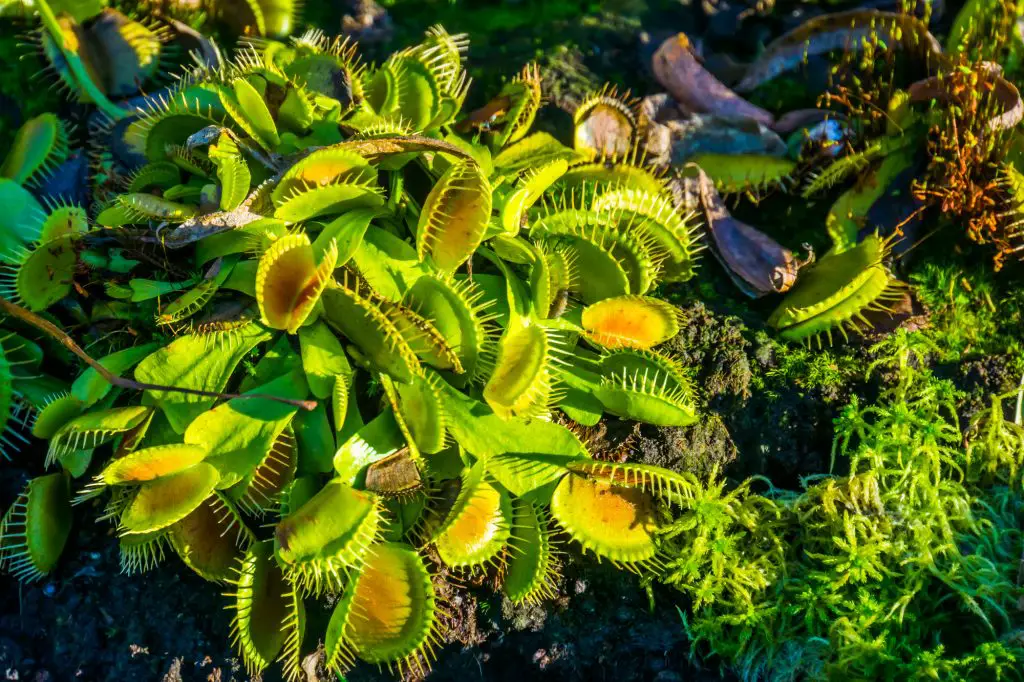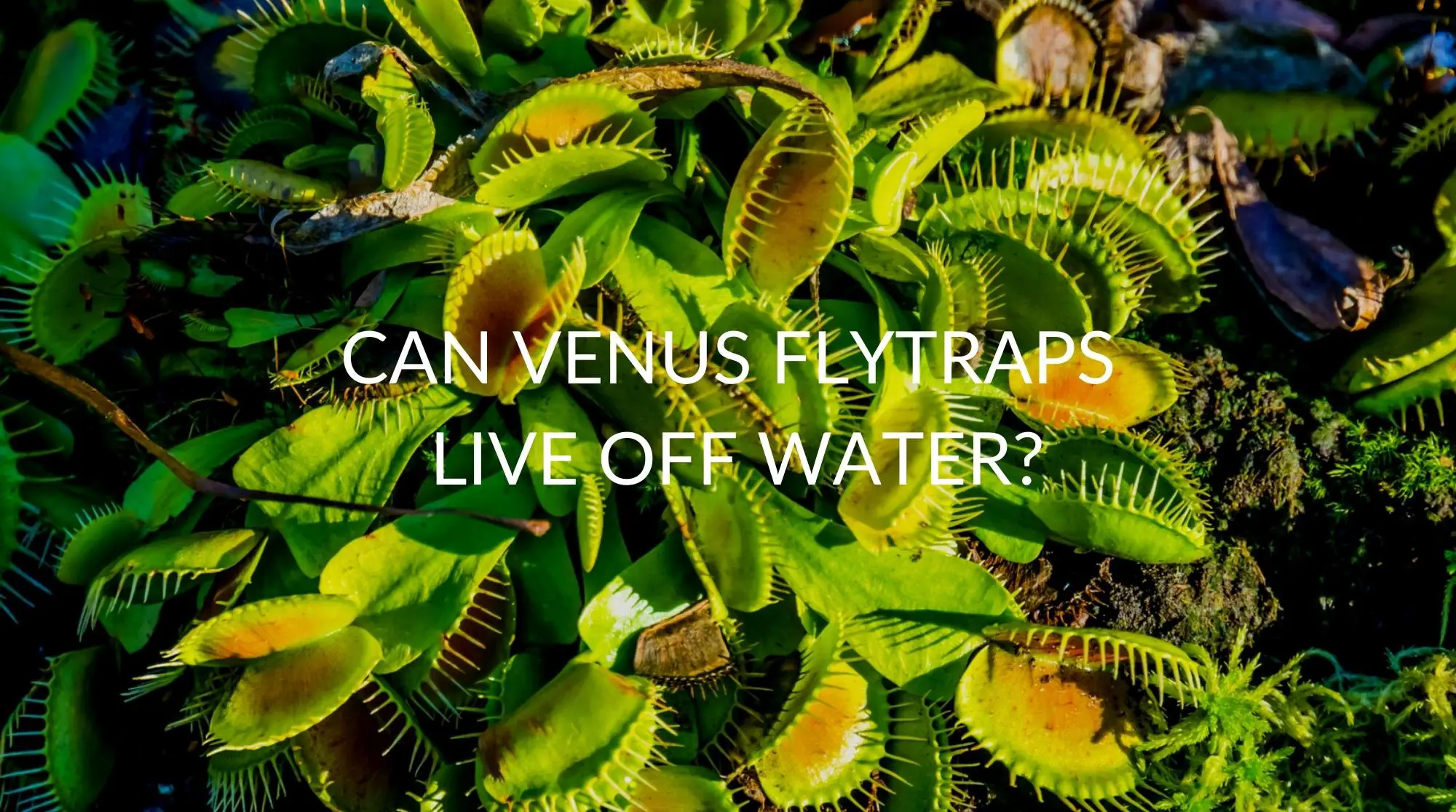Taking care of Venus Flytraps is not very complicated, but just like any other plant, they have specific requirements to thrive. One of the most common questions regarding Venus flytrap care as to how much water they need and whether they can live off water alone.
So, in this article, we’ll find out the water requirements of your Venus flytrap and whether they can survive only with water. We’ll also know the best watering practices for your Venus flytrap, so keep on reading!
Do Venus Fly Traps Need Water?
Venus flytraps do need water to live. These plants are native to regions with high humidity levels and high rainfall. They need to be watered every 2 to 4 days all year round, and their soil needs to be kept continually damp but not soaked.
Overwatering and underwatering Venus flytraps is a common cause of plant ill health and death.
If you are underwatering your plant, it will appear droopy, and the leaves (or traps) will begin to dry out and wither. If the stem and bulb dry out too much, the plant will die.
If you are overwatering your Venus flytrap, a layer of whitish mold will appear on the surface of the soil. Eventually, the excess water will cause the bulb of the plant to soften and rot, and the plant will die.
Do Venus Flytraps Need A Lot Of Water?
Because Venus flytraps are associated with high humidity environments, it is tempting to keep the plants constantly drenched. However, what Venus flytraps really need is to be kept damp rather than soaked.
Learning how to recreate the correct environment for a Venus flytrap can only come with experience. Expert flytrap growers have developed numerous watering methods to keep the plants happy.
This includes when the plants enter their very important dormant stage. During this time (typically during the colder months) a Venus flytrap can appear dying or dead. They lose form, color, and leaves.
If you can see any trace of green still on the plant, then the plant is merely dormant and should be left alone. They still need water during this time – but not very much.
Many Venus flytraps die during dormancy because anxious growers mistake the dormant plant for a dying plant and supply extra water to wake it up. There is no need to do this.
How Much Water Does A Venus Flytrap Need?
Venus flytraps should be watered every 3 to 4 days, depending on where they are kept and the time of the year. Plants kept outside will need a little more water than those indoors. Venus flytraps need water during dormancy, but less than during the “growing” months.
Top water the plants until all the soil is thoroughly moistened (but not soaking). Keep an eye on the soil. It should always remain damp. As soon as it appears to be drying out, repeat the process.
You can also stand the plants in pools of water or water trays. Remove the plants after a couple of hours. The water needs to be able to drain away from the roots. Leaving the pots standing in water for too long causes root rot and fungus problems.

Can Venus Flytraps Live Off Water?
Venus Flytraps cannot live on water alone. They also need sunlight. Venus flytraps can go for a few months on just water and sunlight.
However, they do thrive on insects as well. Venus flytraps in the wild, and those grown and kept outdoors, will naturally catch their own live insect prey.
Venus flytraps that are grown indoors need to be supplied with adequate light and water and a few bugs as well. The plants need at least 4 hours of direct sunlight.
If you’re going to supply other food for your flytrap, don’t be tempted to feed it human food. The plants don’t digest it. The pieces of food will sit in the plant’s traps and eventually rot. This will cause the trap to rot with the food and eventually die and fall off the plant.
It’s also important to avoid supplying your plant with dead bugs. A dead insect won’t trigger the trap to close and begin the digestion process. The insect also needs to be small enough that the trap can close around it completely.
Finally, don’t be tempted to trigger the traps for no reason or to offer food the plant neither wants nor needs. Triggering the traps weakens them, and they will eventually turn black and fall from the plant.
A Venus flytrap only needs one insect every 3 to 4 weeks.
How To Water Your Venus Flytrap
First of all, choose the right kind of water. Venus flytraps will only grow in low mineral, low nutrient soil and low mineral and low salt water. This means they can only tolerate rainwater, reverse osmosis water, and distilled water.
Venus flytraps are bog plants and do not like their soil drying out. They need a humid environment but cannot tolerate being waterlogged. Venus flytraps also don’t need a terrarium.
Many growers water flytraps by placing the pot in a saucer of water every third day for around two hours. In summer, you may need to do this every day if your Venus flytraps live outside.
Never leave the pot standing in water for longer than this, or your flytrap will begin to suffer from root rot.
Don’t use tap water. Tap water contains too many minerals, and these accumulate in the soil and will eventually weaken and kill the plant. If your plant’s leaves are very slowly turning yellow, check your water source.
Venus flytraps have evolved to absorb their minerals and nutrients from the insect life they trap and digest. This has made them intolerant of high nutrient soils, fertilizers, and standard tap water.
What Sort Of Water Is Best For Venus Flytraps?
There are three types of water you can use to keep your Venus flytraps alive. Using any other kind of water will put the health of your plants at risk.
- Reverse osmosis water – reverse osmosis refers to a technology which water is purified by being forced under pressure through a semi-permeable membrane. Reverse osmosis water is lower is salts, parasites, and bacteria than standard water.
- Distilled water – distilled water has been purified through a boiling process after which the water vapour is condensed back into a different container. All contaminants and minerals are removed, leaving it highly suitable for Venus flytraps.
- Rainwater – rainwater is natural free of ground minerals and salts and chemicals such as chlorine. Rainwater is free of all chemicals associated with tap water. These include calcium, sulphur, chlorine, and magnesium, all of which are dangerous for Venus flytraps
FAQ
How Can I Keep My Venus Flytraps Watered When I’m Away From Home?
If you’re going away for a while, and particularly during the summer months, you need a way to keep your flytraps moist. You can do this using the water tray method so long as it’s only a temporary measure.
Place your flytrap pot (or pots) in a shallow tray. The water level should be around one-third the depth of the pot. The plants will water from the bottom up.
After a couple of hours, you would normally remove the plants and let the pots drain. If you’re away for a couple of days, they should still be fine – but remember to remove them from the water as soon as you get home.
At this point, you’ll need to either water them thoroughly (if they’re a little dry) or let them drain completely.
What’s the Best Kind of Soil for Growing Venus Flytraps?
Venus flytraps need poor quality soil without nutrients of any kind. The soil needs to be a fast-draining soil made up of peat moss and perlite. Never add fertilizer to the soil as it can kill the plant.
Gardenerspath advises that watering your flytraps using the water tray method will only work if the plant soil is a proper flytrap mixture: nutrient-free and fast draining. Anything else will cause the soil to become heavy and wet, and the plant will rot.
Can You Mist Venus Flytraps?
You can mist Venus flytraps, but they don’t really need it. Although they grow naturally in humid environments, misting the plants doesn’t really create a proper humid environment anyway.
Pot watering is a far more effective way to water Venus flytraps. Watering from the bottom up allows you to assess the moisture level in the soil.
Misting the plant will also mist the soil, but only the top layer. Therefore, the soil may appear moist, but this will only apply to the top layer.
However, according to Homeguides Gardening, misting carnivorous plants is quite common in very dry environments.
Summary
Venus flytraps are popular plants because they are both attractive and enchanting, so much so that many growers refer to them as pets. Flytraps also tend to be misunderstood in terms of what they eat, what they need, how they grow, and what they should look like.
Experts advise that success with the plants will only come with time and experience, but in the meantime, enjoy them as much as you can!

